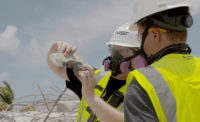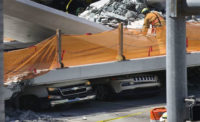The final report on the Miami bridge collapse, released Nov. 12, adds new details on the project team’s numerous failures leading up to the tragedy, especially those committed by FIGG Bridge Engineers and Louis Berger Group.
Also, NTSB Vice Chairman Bruce Landsberg adds to the agency’s assessment with a scathing statement that notes, in part: “The bridge was not properly designed, and there was no qualified oversight on that design. When the inevitable began to happen—a creeping, catastrophic material failure, nobody did anything, despite what NTSB Chairman Sumwalt accurately described as the ‘bridge screaming at everyone that it was failing.’ Why?” (Readers can view Landsberg’s full statement here.)
Among the new details in the transport safety board's final report are descriptions of the engineer-of-record's actions on the morning of the collapse.
Both FIGG and Louis Berger Group, now part of WSP, declined further comment.
The NTSB’s probable cause statement remains unchanged from its Oct. 22 announcement, with the agency citing “load and capacity calculation errors made by FIGG Bridge Engineers, Inc. in its design of the main span truss member 11/12 nodal region and connection to the bridge deck,” along with an “inadequate peer review performed by Louis Berger” and “the failure of the FIGG engineer of record to identify the significance of the structural cracking observed in this node before the collapse.”
Without naming him, the agency details the inaction of engineer-of-record Denney Pate—who is frequently referred to as “the FIGG EOR”—and others with FIGG who repeatedly emphasized to contractor MCM, and other project team members, that the extensive cracking occurring across the unfinished structure posed no safety hazard.
On March 13, for instance, just two days before the March 15 collapse, a FIGG design manager twice told MCM that the cracking did not constitute a hazard, stating first, “We do not see this as a safety issue.” Later that same day, the design manager reiterated: “Again, we have evaluated this further and confirmed that this is not a safety issue.”
Additionally, on the morning of the collapse, Pate led a presentation to project team members—including FDOT, Florida International University, MCM and construction inspection firm Bolton, Perez and Associates—where he noted that “there is no safety concern relative to the observed cracks and minor spalls.”
________________________________________________
Full Text of the Final NTSB Miami Bridge Collapse Report
________________________________________________
That statement to the project team came shortly after Pate and another FIGG employee “went onto the main span and viewed the cracks at the member 11/12 nodal region,” where the collapse would occur later that day.
According to NTSB, “The FIGG employee (not the EOR) took seven photographs of the cracks. The FIGG EOR did not view these photographs before, during, or after the 9:00 a.m. meeting.”
Additionally, the agency reported, “Prior to the presentation, MCM provided site inspection photographs to the FIGG EOR, and he stated during the meeting that ‘the cracks look more significant in person than on the photographs.’”
Design and Peer Review Errors Cited
The bridge project was to span multiple lanes of traffic and link the Florida International University campus to the neighboring community.
According to NTSB, FIGG’s unique design, a concrete truss, “led to the circumstances that accounted for the collapse of the pedestrian bridge,” including an underestimation of “the demand (loads imposed on structural members) that would be acting on the nodal area (11/12),” where the bridge failed. The agency calculated that “the demand for the node was nearly twice what the design team had calculated.”
Further, FIGG’s use of “incorrect loads and load factors in its calculations” led to an overestimation of capacity which “resulted in a node that lacked the capacity to resist the shear force pushing the node to the end of the bridge.”
The agency notes that it was unable to determine from FIGG’s plans exactly how the firm had calculated the capacity and demand estimates. As a result, investigators used AASHTO guidelines to determine these estimates for themselves.
The Louis Berger Group's partial peer review failed to catch these alleged design errors. The NTSB found that though Berger has admitted to performing a limited peer review of the bridge’s design, FIGG never authorized anything less than a full review.
Instead, “the review conducted by this firm did not evaluate the nodes of the bridge truss where they connected with the bridge deck and canopy, nor did it consider the multiple stages the bridge construction involved,” the report states.
Originally, FIGG had planned on another of its offices performing the peer review, but that was not allowed by FDOT regulations.
Instead, in August 2016, FIGG negotiated with Louis Berger to perform this work. The engineer cut Berger’s fee from the $110,000 it had bid to $61,000, with FIGG informing Berger that nevertheless “the original scope of work remained unchanged,” NTSB reported.
In response to the fee cut, “Louis Berger reduced its timeframe for the project from 10 weeks to 7 weeks, to meet FIGG’s requirements.”
In a post-collapse interview, Berger's peer-review engineer told NTSB: “In the beginning, I suggested to do this kind of analysis, to analyze the connections. I'm talking about the nodes, or the joints to analyze the connections. However, the budget and time to do this actually was not agreed upon with the designer.”
In his statement, Landsberg, the NTSB vice chairman, comments: “The reason given (by Berger) was there wasn’t enough money in the project to cover their efforts. That’s both disingenuous and unconscionable. It also was in violation of FDOT’s requirement that there be an independent second set of eyes to review everything – not just what was economically convenient.”
Fix Attempt Proves Fatal
FIGG’s review of cracking photos submitted by MCM and Bolton, Perez eventually led to an attempt to fix the problem.
On March 13, the NTSB reports that FIGG officials recommended a plan to MCM for “restressing the temporary PT rods in member 11 to return it to its previous state when the cracks were known by MCM to have been smaller.”
FIGG decided on that course of action based on the fact that cracking had worsened after crews had de-tensioned the temporary PT rods in members 2 and 11.
The morning of the collapse, FIGG presented its plan to retension member 11—which NTSB calls a “a rushed change order for construction”—to FDOT, FIU, MCM, and Bolton, Perez. The post-tensioning inspection contractor, The Corradino Group, was only notified of the plan that same morning, but was not onsite when the work was performed and the collapse occurred.
The NTSB found that no independent peer review was ever performed of FIGG’s plan to fix the cracking as it should have been, since it was not originally included as part of the engineer’s plans.
According to NTSB, “Post-collapse, the FIGG EOR stated that the retensioning of this truss member would bring the main span back to its ‘pre-existing condition’—of a previous stage. According to FIGG, this decision was based on judgment that returning the main span to its preexisting condition was not a change to the FIGG design and was the right thing to do.”
The NTSB report rejects the notion of any attempted fix resulting in returning the structure to its pre-existing condition.
“The retensioning of member 11 on March 15 was the final stressing force that resulted in the failure of the member 11/12 nodal region. The FIGG design did not show the restressing of member 11, nor would the restressing have returned the node to its pre-cracking condition.
“Therefore, the NTSB concludes that the restressing of member 11 was a manipulation of loads that constituted a change to the FIGG design, and, before being implemented, should have been independently peer reviewed and signed and sealed by a P.E.,” added NTSB.
When the member 11/12 nodal region failed, at approximately 1:47 pm on March 15, 2018, the structure came crashing down in seconds, killing one project worker and five people stranded in vehicles underneath the unfinished bridge.
Prediction: Landmark Case Study
In his statement, Vice Chairman Landsberg notes the exceptional nature of the FIU bridge collapse by stating that “Engineering schools will use this as a landmark case study for years – and they should.”
Landsberg goes on to decry the “group think” that appeared to infect all members of the bridge team, stating: “It appears that (this) mindset was in play here, in every organization: FIGG, LB, MCM…, Bolton Perez..., FDOT, and finally, Florida International University.
“It also appears that every organization absolved themselves of responsibility by rationalizing that if the EOR says it’s OK, it must be OK, and if anything bad happens – it’s on him,” he continued. “That is not the intent of peer review or safety oversight, and certainly fails the system of checks and balances in place to prevent catastrophes like these.”
Again, readers can view the full report here, and Landsberg’s full statement here.






Post a comment to this article
Report Abusive Comment